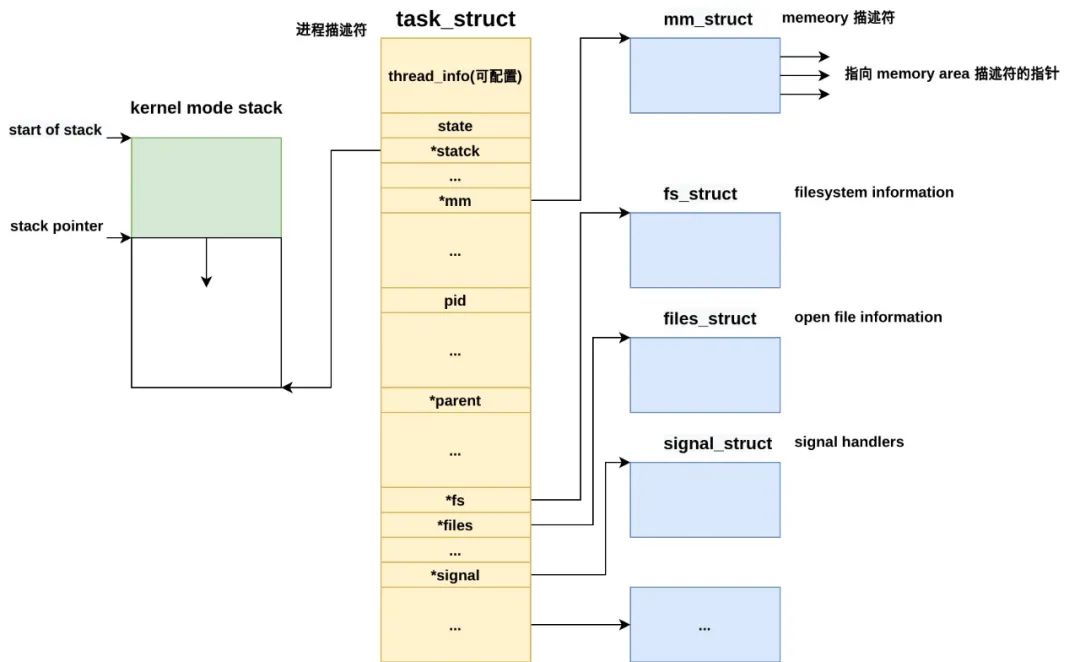

Linux的进程
描述
目的:
初步了解进程描述符 task_struct。
目录:
Linux的进程
Linux 的进程描述符
task_struct
内核如何找到 task_struct
task_struct 的分配和初始化
实验:打印 task_struct / thread_info / kernel mode stack
环境:
Linux-4.14 + ARMv7
1. Linux 的进程
进程的术语是 process,是 Linux 最基础的抽象,另一个基础抽象是文件。
最简单的理解,进程就是执行中 (executing, 不等于running) 的程序。
更准确一点的理解,进程包括执行中的程序以及相关的资源(包括cpu状态、打开的文件、挂起的信号、tty、内存地址空间等)。
一种简洁的说法:进程 = n*执行流 + 资源,n>=1。
Linux 进程的特点:
通过系统调用 fork() 创建进程,fork() 会复制现有进程来创建一个全新的进程。
内核里,并不严格区分进程和线程。
从内核的角度看,调度单位是线程 (即执行流)。可以把线程看做是进程里的一条执行流,1个进程里可以有1个或者多个线程。
内核里,常把进程称为 task 或者 thread,这样描述更准确,因为许多进程就只有1条执行流。
内核通过轻量级进程 (lightweight process) 来支持多线程。1个轻量级进程就对应1个线程,轻量级进程之间可以共享打开的文件、地址空间等资源。
2. Linux 的进程描述符
2.1 task_struct
内核里,通过 task_struct 结构体来描述一个进程,称为进程描述符 (process descriptor),它保存着支撑一个进程正常运行的所有信息。
每一个进程,即便是轻量级进程(即线程),都有1个 task_struct。
sched.h (includelinux) struct task_struct { struct thread_info thread_info; volatile long state; void *stack; [...] struct mm_struct *mm; [...] pid_t pid; [...] struct task_struct *parent; [...] char comm[TASK_COMM_LEN]; [...] struct files_struct *files; [...] struct signal_struct *signal; }
这是一个庞大的结构体,不仅有许多进程相关的基础字段,还有许多指向其他数据结构的指针。
它包含的字段能完整地描述一个正在执行的程序,包括 cpu 状态、打开的文件、地址空间、挂起的信号、进程状态等。

点击查看大图
作为初学者,先简单地了解部分字段就好::
struct thread_info thread_info:进程底层信息,平台相关,下面会详细描述。
long state:进程当前的状态,下面是几个比较重要的进程状态以及它们之间的转换流程。
点击查看大图
void *stack:指向进程内核栈,下面会解释。
struct mm_struct *mm:与进程地址空间相关的信息都保存在一个叫内存描述符 (memory descriptor) 的结构体 (mm_struct) 中。
点击查看大图
pid_t pid:进程标识符,本质就是一个数字,是用户空间引用进程的唯一标识。
struct task_struct *parent:父进程的 task_struct。
char comm[TASK_COMM_LEN]:进程的名称。
struct files_struct *files:打开的文件表。
struct signal_struct *signal:信号处理相关。
其他字段,等到有需要的时候再回过头来学习。
2.2 当发生系统调用或者进程切换时,内核如何找到 task_struct ?
对于 ARM 架构,答案是:通过内核栈 (kernel mode stack)。
为什么要有内核栈?
因为内核是可重入的,在内核中会有多条与不同进程相关联的执行路径。因此不同的进程处于内核态时,都需要有自己私有的进程内核栈 (process kernel stack)。
当进程从用户态切换到内核态时,所使用的栈会从用户栈切换到内核栈。
至于是如何切换的,关键词是系统调用,这不是本文关注的重点,先放一边,学习内核要懂得恰当的时候忽略细节。
当发生进程切换时,也会切换到目标进程的内核栈。
同上,关键词是硬件上下文切换 (hardware context switch),忽略具体实现。
无论何时,只要进程处于内核态,就会有内核栈可以使用,否则系统就离崩溃不远了。
ARM 架构的内核栈和 task_struct 的关系如下:
内核栈的长度是 THREAD_SIZE,对于 ARM 架构,一般是 2 个页框的大小,即 8KB。
内核将一个较小的数据结构 thread_info 放在内核栈的底部,它负责将内核栈和 task_struct 串联起来。thread_info 是平台相关的,在 ARM 架构中的定义如下:
// thread_info.h (archarmincludeasm) struct thread_info { unsigned long flags; /* low level flags */ int preempt_count; /* 0 => preemptable, <0 => bug */ mm_segment_t addr_limit; /* address limit */ struct task_struct *task; /* main task structure */ [...] struct cpu_context_save cpu_context; /* cpu context */ [...] };
thread_info 保存了一个进程能被调度执行的最底层信息(low level task data),例如struct cpu_context_save cpu_context 会在进程切换时用来保存/恢复寄存器上下文。
内核通过内核栈的栈指针可以快速地拿到 thread_info:
// thread_info.h (includelinux) static inline struct thread_info *current_thread_info(void) { // current_stack_pointer 是当前进程内核栈的栈指针 return (struct thread_info *) (current_stack_pointer & ~(THREAD_SIZE - 1)); }
然后通过 thread_info 找到 task_struct:
// current.h (includeasm-generic) #define current (current_thread_info()->task)
内核里通过 current 宏可以获得当前进程的 task_struct。
2.3 task_struct 的分配和初始化
当上层应用使用 fork() 创建进程时,内核会新建一个 task_struct。
进程的创建是个复杂的工作,可以延伸出无数的细节。这里我们只是简单地了解一下 task_struct 的分配和部分初始化的流程。
fork() 在内核里的核心流程:
dup_task_struct() 做了什么?
至于设置内核栈里做了什么,涉及到了进程的创建与切换,不在本文的关注范围内,以后再研究了。
3. 实验:打印 task_struct / thread_info / kernel mode stack
实验目的:
梳理 task_struct / thread_info / kernel mode stack 的关系。
实验代码:
#include
运行效果:
task module init insmod 3123 task_struct (edb42580) / stack(ed46c000~ed474000) / thread_info->task (edb42580) bash 2393 task_struct (eda13e80) / stack(c9dda000~c9de2000) / thread_info->task (eda13e80) sshd 2255 task_struct (ee5c9f40) / stack(c9d2e000~c9d36000) / thread_info->task (ee5c9f40) sshd 543 task_struct (ef15f080) / stack(ee554000~ee55c000) / thread_info->task (ef15f080) systemd 1 task_struct (ef058000) / stack(ef04c000~ef054000) / thread_info->task (ef058000)
在程序里,我们通过 task_struct 找到 stack,然后通过 stack 找到 thread_info,最后又通过 thread_info->task 找到 task_struct。
4. 相关参考
Linux 内核设计与实现 / 第 3.1 章节
深入理解 Linux 内核 / 3
Linux 内核深度解析 / 2.5.1
深入Linux 内核架构 / 2.3
责任编辑:lq
-
Linux进程通信视频教程2009-12-22 0
-
Linux进程间通信——使用共享内存2017-11-21 0
-
Linux的进程、线程以及调度2020-05-15 0
-
Linux的进程管理工具之Supervisor2020-06-12 0
-
Linux进程和线程的区别是什么?2021-03-11 0
-
LINUX 进程源代码分析2010-02-09 289
-
LINUX进程源代码分析2011-04-03 417
-
Linux进程控制编程2017-10-18 495
-
基于Linux进程管理的详细剖析2018-01-26 3473
-
Linux进程调度时机概念分析2020-01-23 2536
-
虚拟机:linux 进程的最大线程个数2020-06-22 2453
-
Linux进程的概念说明2020-07-14 638
-
一行代码教你如何隐藏Linux进程2020-09-15 2046
-
你们知道Linux的进程是怎样创建的吗2021-11-09 2974
-
如何实现一套linux进程间通信的机制2023-11-10 373
全部0条评论

快来发表一下你的评论吧 !

